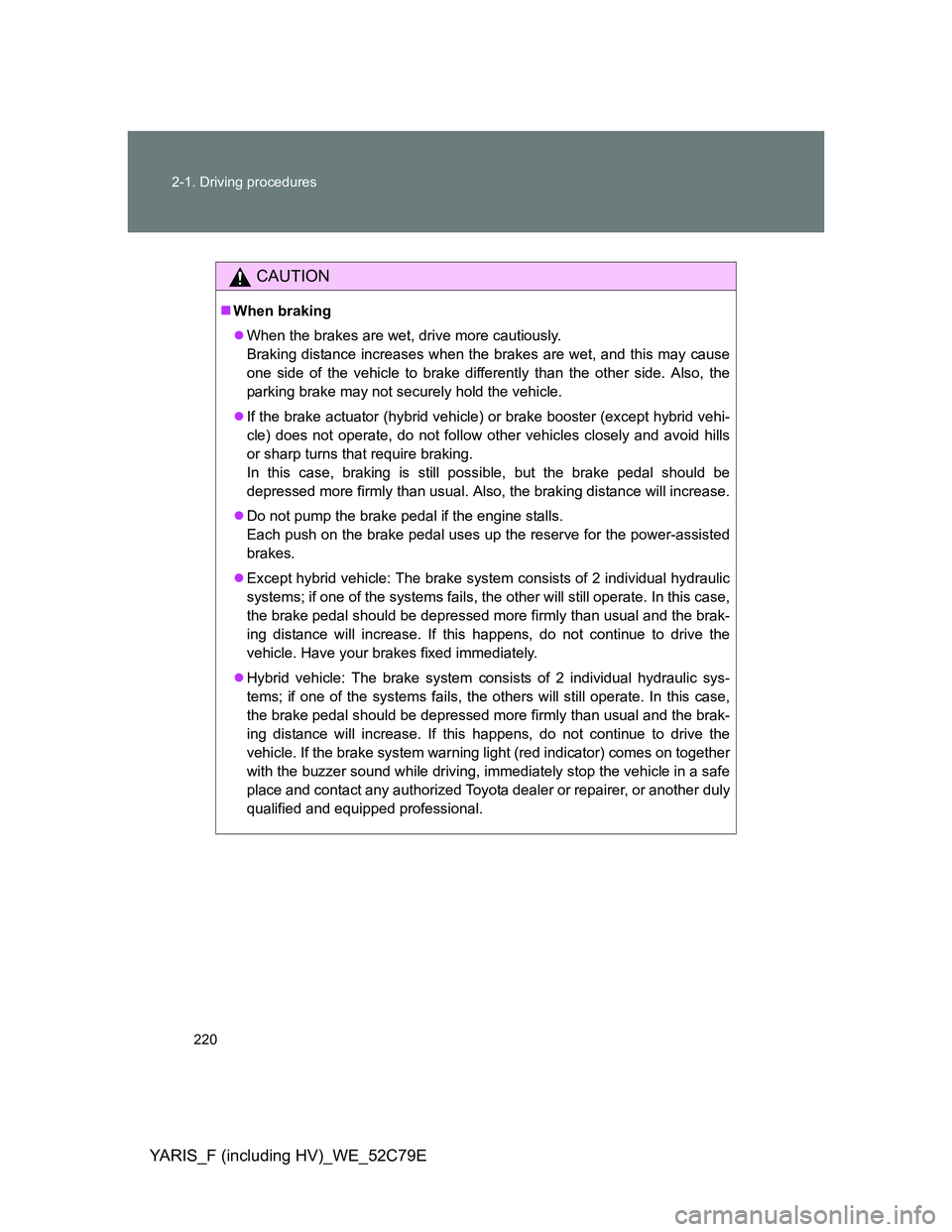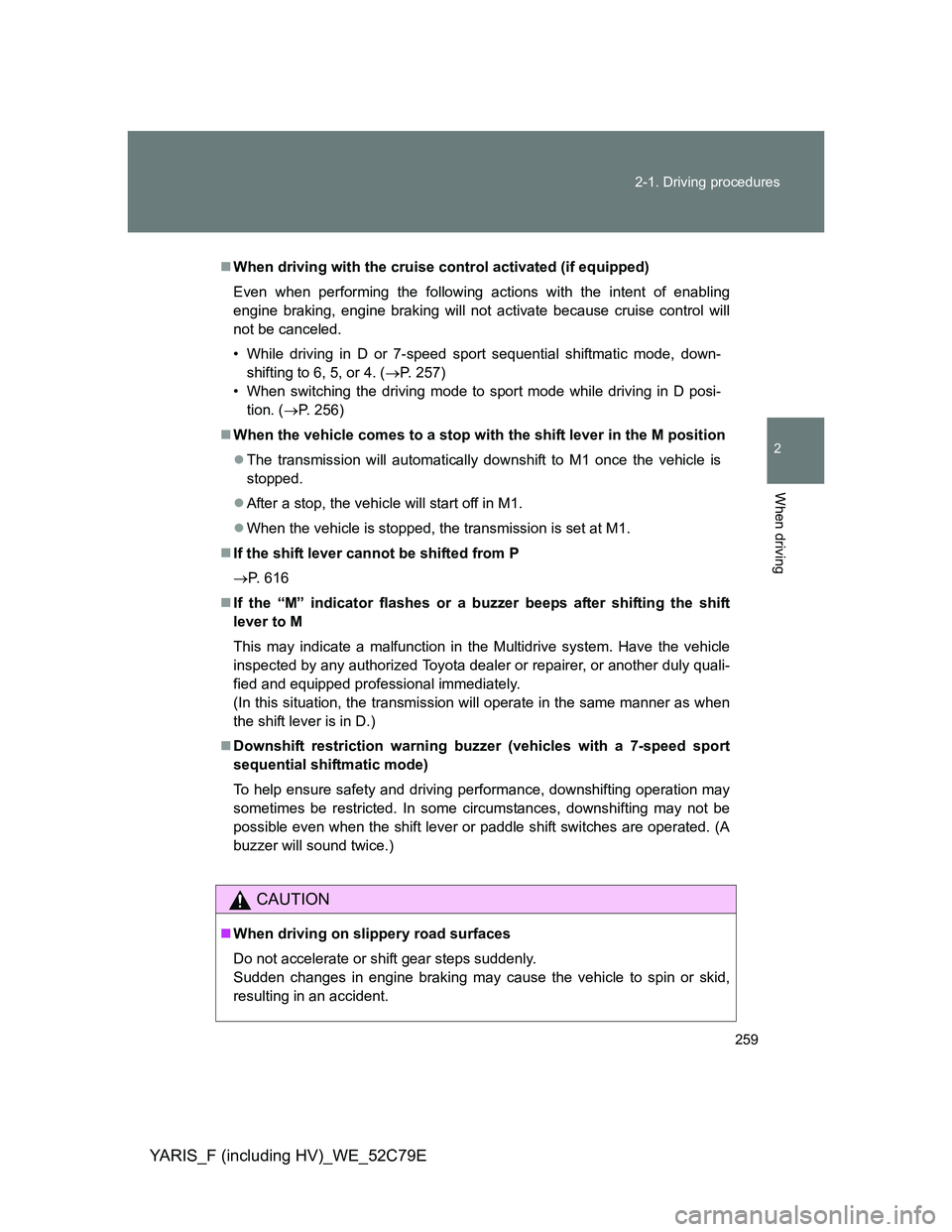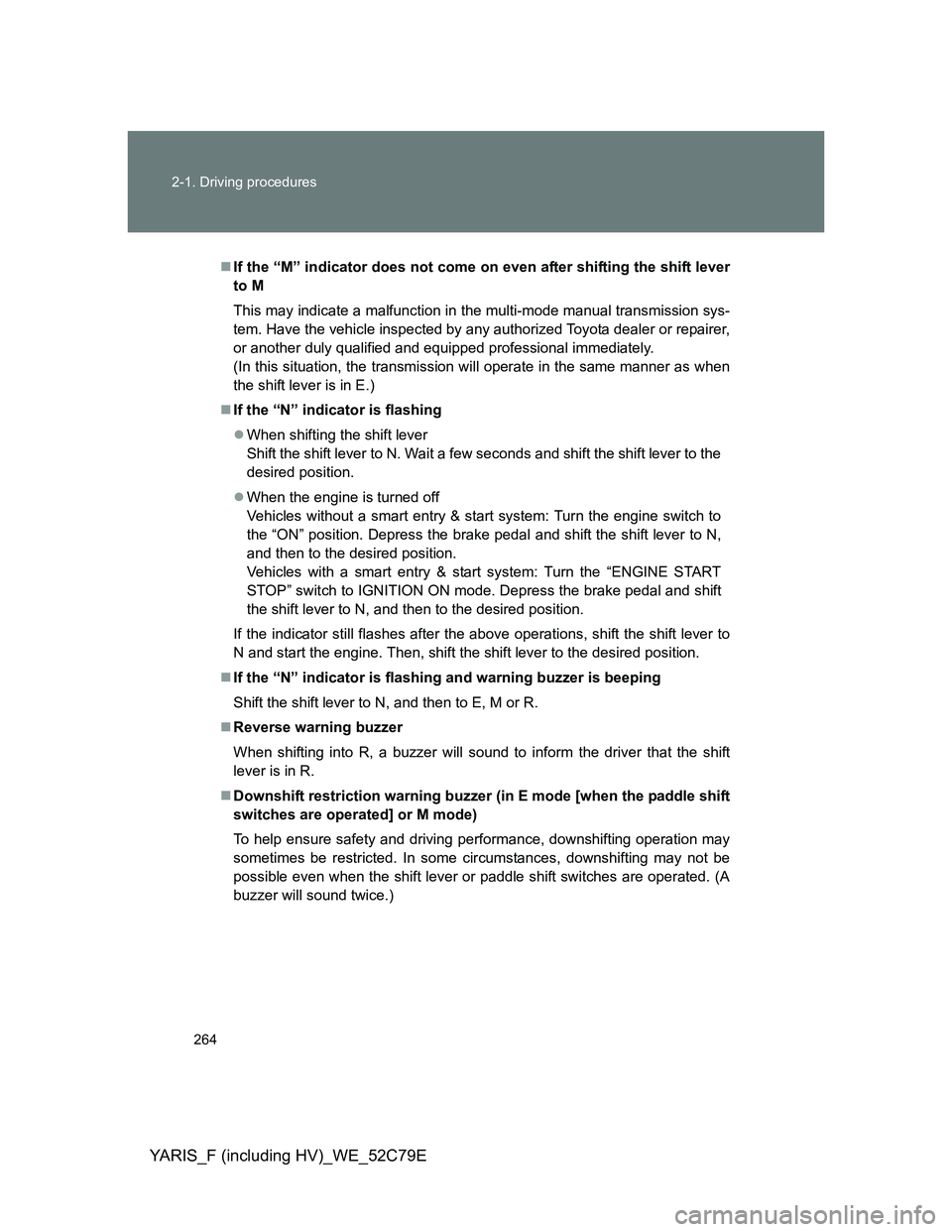Page 203 of 704

2When driving
203
YARIS_F (including HV)_WE_52C79E
2-1. Driving procedures
Driving the vehicle ............ 204
Engine (ignition) switch
(except hybrid vehicle
[vehicles without a smart
entry & start system])...... 224
Engine (ignition) switch
(except hybrid vehicle
[vehicles with a smart
entry & start system])...... 228
Engine (ignition) switch
(hybrid vehicle [vehicles
without an electronic
key]) ................................ 238
Power (ignition) switch
(hybrid vehicle [vehicles
with an electronic key]) ... 243
EV drive mode
(hybrid vehicle) ............... 250
Hybrid transmission .......... 252
Multidrive .......................... 255
Multi-mode manual
transmission ................... 260
Manual transmission......... 265
Turn signal lever ............... 269
Parking brake ................... 271
Horn .................................. 272
2-2. Instrument cluster
Gauges and meters .......... 273
Indicators and warning
lights ............................... 278
Multi-information display ... 2862-3. Operating the lights and
wipers
Headlight switch................ 293
Fog light switch ................. 302
Windshield wiper and
washer ............................ 304
Rear window wiper and
washer ............................ 309
2-4. Using other driving systems
Cruise control.................... 311
Speed limiter ..................... 315
Stop & Start system .......... 318
Driving assist systems ...... 326
Hill-start assist control
(hybrid vehicle) ............... 332
Diesel particulate filter
system ............................ 334
2-5. Driving information
Cargo and luggage ........... 336
Winter driving tips ............. 338
Trailer towing
(hybrid vehicle) ............... 342
Trailer towing (except hybrid
vehicle [except for
South Africa]) .................. 343
Page 220 of 704

220 2-1. Driving procedures
YARIS_F (including HV)_WE_52C79E
CAUTION
When braking
When the brakes are wet, drive more cautiously.
Braking distance increases when the brakes are wet, and this may cause
one side of the vehicle to brake differently than the other side. Also, the
parking brake may not securely hold the vehicle.
If the brake actuator (hybrid vehicle) or brake booster (except hybrid vehi-
cle) does not operate, do not follow other vehicles closely and avoid hills
or sharp turns that require braking.
In this case, braking is still possible, but the brake pedal should be
depressed more firmly than usual. Also, the braking distance will increase.
Do not pump the brake pedal if the engine stalls.
Each push on the brake pedal uses up the reserve for the power-assisted
brakes.
Except hybrid vehicle: The brake system consists of 2 individual hydraulic
systems; if one of the systems fails, the other will still operate. In this case,
the brake pedal should be depressed more firmly than usual and the brak-
ing distance will increase. If this happens, do not continue to drive the
vehicle. Have your brakes fixed immediately.
Hybrid vehicle: The brake system consists of 2 individual hydraulic sys-
tems; if one of the systems fails, the others will still operate. In this case,
the brake pedal should be depressed more firmly than usual and the brak-
ing distance will increase. If this happens, do not continue to drive the
vehicle. If the brake system warning light (red indicator) comes on together
with the buzzer sound while driving, immediately stop the vehicle in a safe
place and contact any authorized Toyota dealer or repairer, or another duly
qualified and equipped professional.
Page 259 of 704

259 2-1. Driving procedures
2
When driving
YARIS_F (including HV)_WE_52C79E
When driving with the cruise control activated (if equipped)
Even when performing the following actions with the intent of enabling
engine braking, engine braking will not activate because cruise control will
not be canceled.
• While driving in D or 7-speed sport sequential shiftmatic mode, down-
shifting to 6, 5, or 4. (P. 257)
• When switching the driving mode to sport mode while driving in D posi-
tion. (P. 256)
When the vehicle comes to a stop with the shift lever in the M position
The transmission will automatically downshift to M1 once the vehicle is
stopped.
After a stop, the vehicle will start off in M1.
When the vehicle is stopped, the transmission is set at M1.
If the shift lever cannot be shifted from P
P. 616
If the “M” indicator flashes or a buzzer beeps after shifting the shift
lever to M
This may indicate a malfunction in the Multidrive system. Have the vehicle
inspected by any authorized Toyota dealer or repairer, or another duly quali-
fied and equipped professional immediately.
(In this situation, the transmission will operate in the same manner as when
the shift lever is in D.)
Downshift restriction warning buzzer (vehicles with a 7-speed sport
sequential shiftmatic mode)
To help ensure safety and driving performance, downshifting operation may
sometimes be restricted. In some circumstances, downshifting may not be
possible even when the shift lever or paddle shift switches are operated. (A
buzzer will sound twice.)
CAUTION
When driving on slippery road surfaces
Do not accelerate or shift gear steps suddenly.
Sudden changes in engine braking may cause the vehicle to spin or skid,
resulting in an accident.
Page 264 of 704

264 2-1. Driving procedures
YARIS_F (including HV)_WE_52C79E
If the “M” indicator does not come on even after shifting the shift lever
to M
This may indicate a malfunction in the multi-mode manual transmission sys-
tem. Have the vehicle inspected by any authorized Toyota dealer or repairer,
or another duly qualified and equipped professional immediately.
(In this situation, the transmission will operate in the same manner as when
the shift lever is in E.)
If the “N” indicator is flashing
When shifting the shift lever
Shift the shift lever to N. Wait a few seconds and shift the shift lever to the
desired position.
When the engine is turned off
Vehicles without a smart entry & start system: Turn the engine switch to
the “ON” position. Depress the brake pedal and shift the shift lever to N,
and then to the desired position.
Vehicles with a smart entry & start system: Turn the “ENGINE START
STOP” switch to IGNITION ON mode. Depress the brake pedal and shift
the shift lever to N, and then to the desired position.
If the indicator still flashes after the above operations, shift the shift lever to
N and start the engine. Then, shift the shift lever to the desired position.
If the “N” indicator is flashing and warning buzzer is beeping
Shift the shift lever to N, and then to E, M or R.
Reverse warning buzzer
When shifting into R, a buzzer will sound to inform the driver that the shift
lever is in R.
Downshift restriction warning buzzer (in E mode [when the paddle shift
switches are operated] or M mode)
To help ensure safety and driving performance, downshifting operation may
sometimes be restricted. In some circumstances, downshifting may not be
possible even when the shift lever or paddle shift switches are operated. (A
buzzer will sound twice.)
Page 277 of 704
277 2-2. Instrument cluster
2
When driving
YARIS_F (including HV)_WE_52C79E
NOTICE
To prevent damage to the engine and its components
Vehicles with a tachometer: Do not let the indicator needle of the tachome-
ter enter the red zone, which indicates the maximum engine speed.
The engine may be overheating if the high engine coolant temperature
warning light flashes or turns on. In this case, immediately stop the vehicle
in a safe place, and check the engine after it has cooled completely.
(
P. 635, 639)
Page 278 of 704
278
2-2. Instrument cluster
YARIS_F (including HV)_WE_52C79E
Indicators and warning lights
The indicators and warning lights on the instrument cluster and cen-
ter panel inform the driver of the status of the vehicle’s various sys-
tems.
For the purpose of explanation, the following illustration displays all
indicators and warning lights illuminated.
Except hybrid vehicle
Instrument cluster (vehicles without a tachometer type A):
Instrument cluster (vehicles without a tachometer type B):
Page 283 of 704

283 2-2. Instrument cluster
2
When driving
YARIS_F (including HV)_WE_52C79E
*2: Hybrid vehicle: These lights turn on when the engine switch is
turned to the “ON” position (vehicles without an electronic key) or
the “POWER” switch is turned to ON mode (vehicles with an elec-
tronic key) to indicate that a system check is being performed. They
will turn off after the hybrid system on, or after a few seconds. There
may be a malfunction in a system if a light does not come on, or if
the lights do not turn off. Have the vehicle inspected by any autho-
rized Toyota dealer or repairer, or another duly qualified and
equipped professional.
*3: The light turns on when the engine coolant temperature is low.
*4: The light flashes to indicate that the system is operating.
Warning lights
Warning lights inform the driver of malfunctions in any of the
vehicle’s systems. (P. 565)
(red)(if equipped)
(if equipped)(yellow:
hybrid
vehicle)(if equipped)(if equipped)(diesel
engine)(if equipped)(if equipped)
(if equipped)(diesel
engine)(diesel
engine)(hybrid
vehicle)(hybrid
vehicle)
(hybrid
vehicle)(hybrid
vehicle)
*1,*2*1,*2*1,*2*1,*2*1*1,*2*1,*2*1,*2
*1,*2*1,*2,6*2*5,*7*1,5*1*3*4
*1*1*2*2
*2*2
Page 285 of 704
285 2-2. Instrument cluster
2
When driving
YARIS_F (including HV)_WE_52C79E
CAUTION
If a safety system warning light does not come on
Should a safety system light such as the ABS and SRS warning light not
come on when you start the engine (except hybrid vehicle) or hybrid system
(hybrid vehicle), this could mean that these systems are not available to help
protect you in an accident, which could result in death or serious injury. Have
the vehicle inspected by any authorized Toyota dealer or repairer, or another
duly qualified and equipped professional immediately if this occurs.